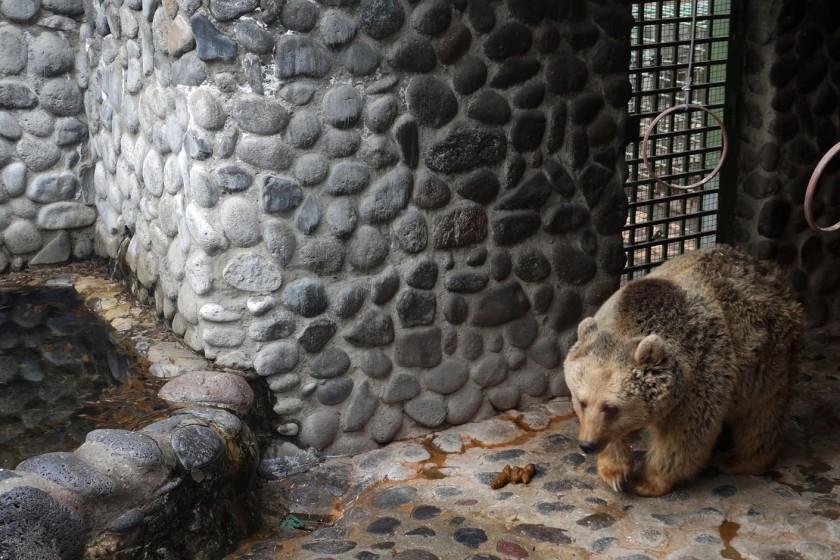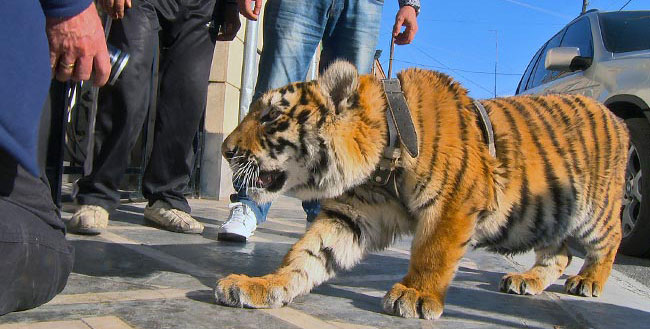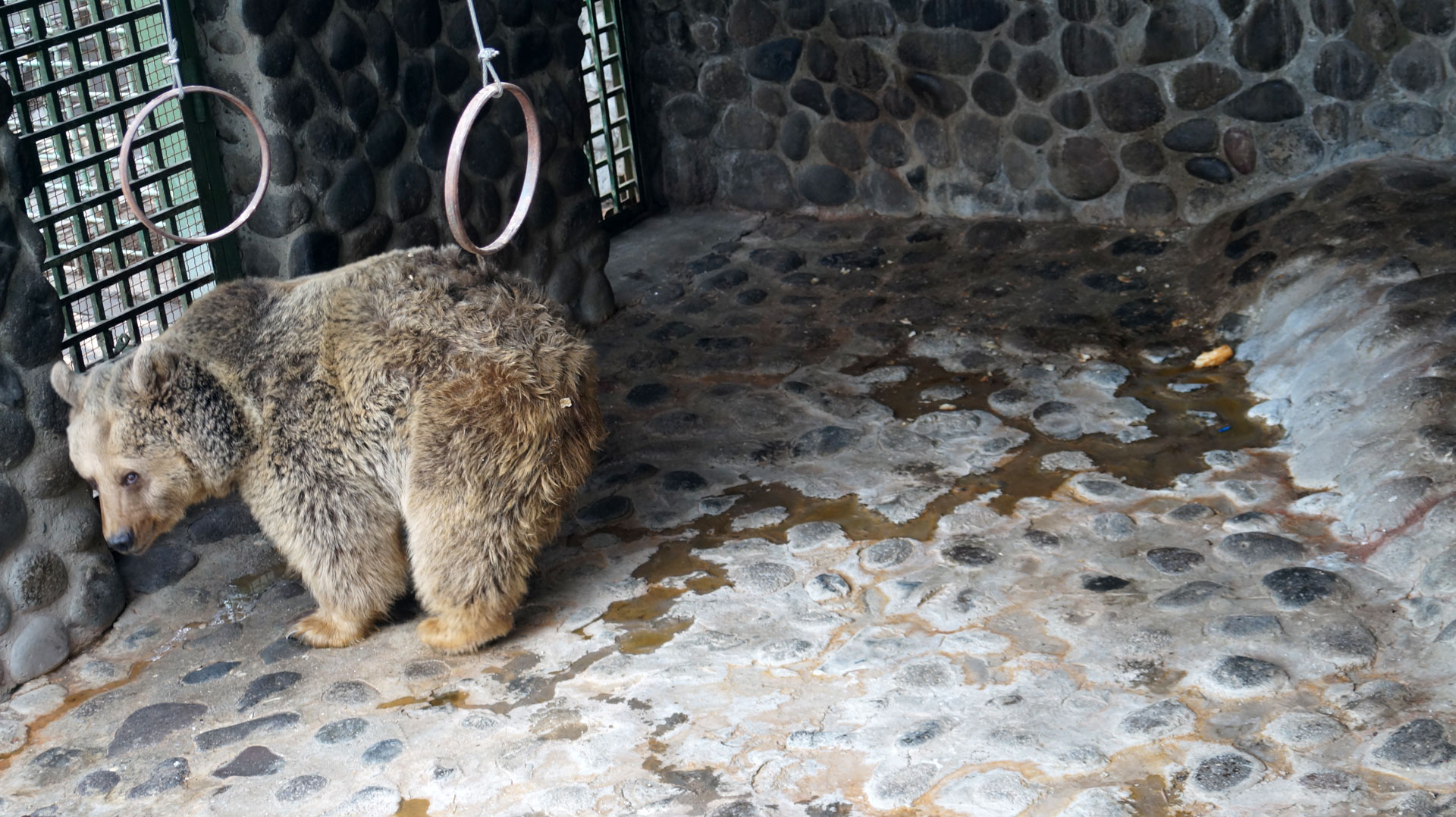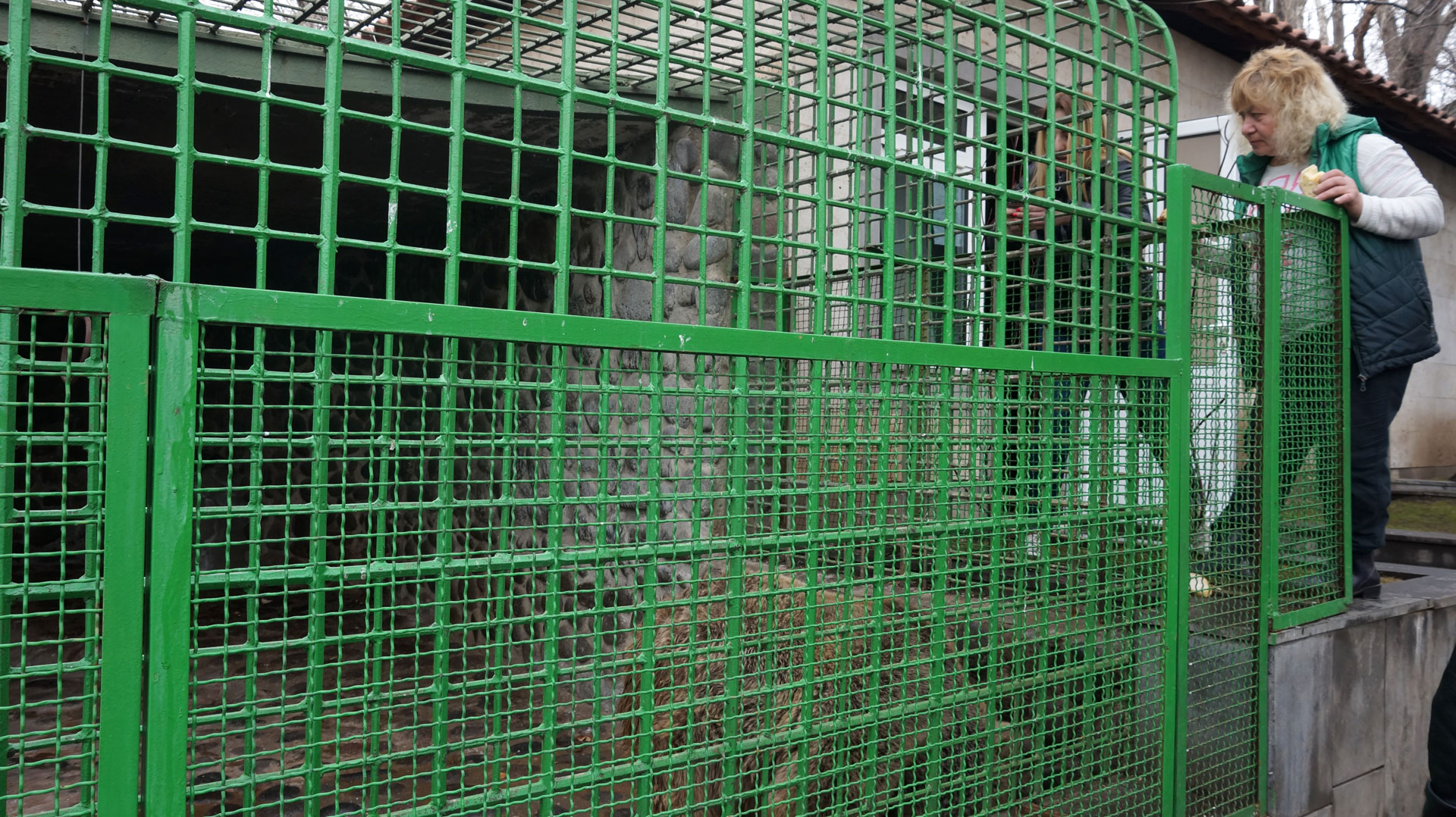
Living Outside the Law; Using Wild Animals in Armenia as Ego Boosters and Business Promoters
Dasha, a resident of the Ardjanots restaurant in Yerevan’s Hrazdan Gorge, has given birth to three cubs.
Misha, Dasha’s mate, is alone in the cage for now. After the cubs have grown a bit, Dasha will join them.
It remains unclear what will happen to the cubs, according to a Ardjanots employee. She says that they’ll either be given to the zoo or anyone who wants them.
Mrs. Nazik, who owns the restaurant, boasts that you can’t find better fed bears anywhere. Dasha and Misha even have their own passports.
 |
 |
Keeping endangered species, especially brown bears, as a commercial attraction at restaurants in Armenia has become an accepted tradition. But there is no state agency looking out for their welfare.
The only time such animals make the news is when an emergency arises; say when a lion attacks someone or escapes. Animal owners are rarely, if ever, held accountable for mistreating them - keeping them in confined spaces are not feeding them properly. The physical and psychological condition of the animals is dependent on the goodwill of the owner.
According to Article 32 of Armenia’s Law on Veterinary Affairs, dealing with the animal welfare: Animals must be bred and kept in accordance with their age, physiological needs and peculiarities of the species.
 Take the example of the tiger owned by General Manvel Grigoryan. The beast’s teeth had been removed and was paraded around Grigoryan’s Etchmiadzin house like some trophy. Isn’t such behavior a violation of the abovementioned law?
Take the example of the tiger owned by General Manvel Grigoryan. The beast’s teeth had been removed and was paraded around Grigoryan’s Etchmiadzin house like some trophy. Isn’t such behavior a violation of the abovementioned law?
Then, there was the case of a brown bear escaping from his enclosure at the Tpoutner Restaurant in Tzaghkadzor last year. The restaurant owners had no permit to keep the bear. News that a bear was being kept on the premises only made the news and state authorities when the animal escaped and was found roaming the streets. (The bear was later captured by emergency crews.)
Things have gotten so out of hand of late that the government is trying to tackle the problem by implementing measure to punish those who keep endangered animals in their homes and businesses.
Usually, the law brought to bear in such cases is Article 294 of Armenia’s Criminal Code which deals with ‘illegal hunting’.
According to Armenia’s Red Book of Animals regarding the status of the brown bear (U. arctos) we read the following:
The brown bear is listed in IUCN Red List with conservation status of “Least Concern” and evaluated as “vulnerable.”
“Vulnerable” according to the IUCN means – High risk of extinction in the wild.
Such is surely the case of the brown bear in Armenia given some population estimates of as low as 150.
Hovhannes Mkrtchyan, who heads the Veterinary Division of Armenia’s Food Safety Service, told Hetq that his agency only monitors the health of animals kept at commercial business sites when owners request such inspections. But the Law on Veterinary Affairs underwent the changes in this regard and government decisions and regulations must be drafted, related to the changes, regarding the standards for keeping animals in public places.
“This issue has never been codified. The only precondition was that someone keeping animals naturally had to provide ample space and a professional veterinarian. In addition to being fed, an animal must be treated, which requires the services of a professional,” Mkrtchyan said, promising that the new law would resolve any outstanding problems.
While changes to the law have been made, Article 35 (The obligations and restrictions of persons regarding guaranteeing the welfare of animals) doesn’t take effect until 2017.
The Shant Restaurant kept a large group of wild and Red Book registered animals until last year – the Transcaucasian brown bear, bezoar ibex, mandrills, and lions. The restaurant finally gave up on keeping animals. Feeding them was too costly. No one knows what happened to the animals. An employee said she had no idea where they went.
The Vasbouragan Restaurant in Djrvezh also keeps a brown bear on the premises. Wild and exotic animals are also to be seen at the Ashtaraki Dzor restaurant.
According to Arevik Mkrtchyan, coordinator for the Foundation for the Preservation of Wildlife and Cultural Assets (FPWC), there are nine business in Yerevan and fourteen outside the capital that have animals.
These stats aren’t official. No official data exists given the absence of a comprehensive registry on which to conduct monitoring of such animals and most importantly their health.
In 2014, Hetq sent an inquiry to Armenia’s Ministry of Nature Protection to find out if it had ever inspected businesses where wild or exotic animals were being kept. The ministry responded that it had inspected 4,250 businesses. It said that such businesses were assessed as low risk, and thus inspections were conducted once every five years.
The ministry claimed that its inspectors never came across any animals registered in the Red Book at those businesses.
In late 2015, Minister of Nature Protection Aramayis Grigoryan, responding to a Hetq query as to when the sector would be regulated, noted that the issue was being discussed, that solutions would be forthcoming, and that legislative changes and oversight mechanisms were being drafted.

One of the well-known businesses in Yerevan where animals are kept is a former bear den, now called the El-Garden, on the Tzitzernakaberd Genocide Memorial site overlooking Yerevan.
Masha, the 29-year-old brown bear, lives here. Hakob, the bear’s keeper, told Hetq last year that Masha has lived here since a cub.
“He was raised on kebab and blinchiki. Customers would come and place an order of kebab for Masha, Hakob said.
On Sunday, when this reporter visited El-Garden, it was immediately apparent that nothing has changed for animals on public display at restaurants and entertainment operations. The laws and so-called legislative reforms exist on paper only. The only change I saw was that the fence around Masha’s enclosure had been reinforced.

Given this total lack of oversight and attention is it any wonder that periodically we read about the appalling conditions that wild animals face in Armenia. Sometimes, such reports even make in the foreign press; take the horrific case of the animals being held in Gyumri, for example.
Believing that one can keep wild animals, some endangered, as pets in Armenia is a fad that hopefully will pass.
Then again, take the example of Prosperous Armenia Party MP Rouben Gevorgyan. He keeps Siberian tigers as pets and believes that tigers in the wild would be “jealous” of the lifestyle of the tigers in his care.
P.S. The Red Book is the most comprehensive information source on the conservation status of plant and animal species in Armenia. It was prepared based on an objective system for assessing the risk of extinction of a species, using the criteria of the IUCN Red List of Threatened Species™. The Red List is used as a basis for countries to step up efforts to assess their biodiversity and to design conservation action.
 Videos
Videos Photos
Photos
Comments (1)
Write a comment